Introducing…Math Mights Subtraction Strategies!
Our Addition Strategies Math Mights posters have been a huge success in the schools that we work with! It’s truly amazing that teachers are not only starting to understand the strategies and how to teach them, but they’re even getting into character!
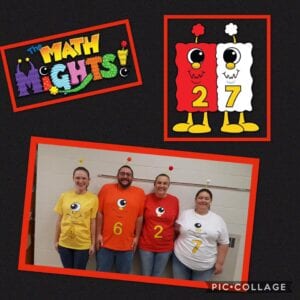 For Twin Day, the 5th grade teachers in one school dressed up as the Value Pak. Each teacher had a different color t-shirt with their number on it and they even had the headband with the single antennae.
For Twin Day, the 5th grade teachers in one school dressed up as the Value Pak. Each teacher had a different color t-shirt with their number on it and they even had the headband with the single antennae.
Another teacher dressed up like Abracus and had a magic wand that she would wave to show she was compensating and changing the number and then changing it back.
I’ve seen many teachers raise the hammer from their Whack-a-Mole game when they’re looking at numbers they know are close to a friendly number because the students associate it with D.C. for decomposing/composing. In one of our 2nd grade classrooms, the teacher holds up the hammer and the kids all know exactly what to do!
Math Mights has truly been a dream come true for me. With all the different math programs that all have different names for strategies, I wanted to pare it down to three ways, plus the traditional, to make it easier for teachers, parents, AND students. I also wanted to integrate the 8 Mathematical Practices and CPA. Fast forward to today – we have Math Mights Addition Strategies Posters in over 300 classrooms!
The Future of Math Mights
Of course, I have grand ideas for more supporting products, but we’ve been taking our time to make sure that the products we release will be effective!
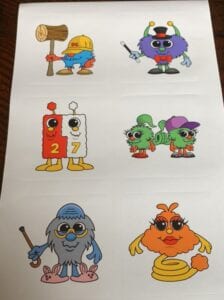 We’ve recently launched some freebie, removable stickers have been included with orders of Math Mights Addition Strategies Posters. Many teachers put them on their doors. Some principals put them up in their window. The stickers been used as a conversation starter building-wide! We overheard a conversation between a 4th grader and a 2nd grader that went something like, “Hey! You know D.C.? How do you know about him?” “Oh, I know about D.C. because he smashes numbers!”
We’ve recently launched some freebie, removable stickers have been included with orders of Math Mights Addition Strategies Posters. Many teachers put them on their doors. Some principals put them up in their window. The stickers been used as a conversation starter building-wide! We overheard a conversation between a 4th grader and a 2nd grader that went something like, “Hey! You know D.C.? How do you know about him?” “Oh, I know about D.C. because he smashes numbers!”
 Videos seem to be our most requested resource, and we have some good news! We have recorded some great video footage of model classrooms where the Math Mights have been implemented with great success. In these classrooms, you’ll see the poster up on the wall. Even after the strategies have all been taught, the Math Mights Addition Strategies poster shouldn’t be hanging on the wall closed! It should be open to the last page that displays all four of the strategies. In the videos, you’ll hear how kids were very readily saying the strategies and the names of the characters, and it was evident that the names of the characters actually help them remember the strategy. Kids might say, “I solved it through Abracus.” And the teacher will ask, ”That’s the character, but what’s the strategy?” and they come right back with compensation!
Videos seem to be our most requested resource, and we have some good news! We have recorded some great video footage of model classrooms where the Math Mights have been implemented with great success. In these classrooms, you’ll see the poster up on the wall. Even after the strategies have all been taught, the Math Mights Addition Strategies poster shouldn’t be hanging on the wall closed! It should be open to the last page that displays all four of the strategies. In the videos, you’ll hear how kids were very readily saying the strategies and the names of the characters, and it was evident that the names of the characters actually help them remember the strategy. Kids might say, “I solved it through Abracus.” And the teacher will ask, ”That’s the character, but what’s the strategy?” and they come right back with compensation!
The character development has been key, in my opinion, to the success of the Math Mights. The characters have to come to life! Adding details to the character’s story, like D.C. for example, and how he has temper tantrums, wears a hard hat and carries a hammer because he can’t stand it when numbers aren’t friendly, help kids identify with the characters and help solidify them and their corresponding strategies in the kids’ memory as they advance from grade to grade. Then, the strategy grows vertically because you can do it with whole numbers, with decimals, and with fractions, and our kids are communicating their reasoning, understanding the strategies, and actually remembering it.
Subtraction World!
The Math Mights live in different worlds, in some ways. The world you know, with D.C., T-Pops, Abracus and Value Pak, is the Addition World. Those characters all have the particular addition strategies they use, and regardless of what math program a district uses, the Math Mights can provide a common language around addition.
We are excited to finally introduce the Math Mights Subtraction Strategies poster and the world of Subtraction within Mathville!
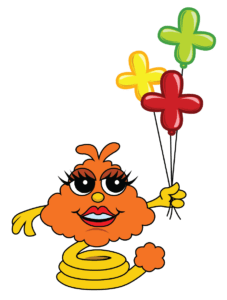 We want to start off by highlighting one of our favorite, brand new, characters: Springling! Her character development has really been pivotal to children’s understanding of subtraction. Springling mirrors the idea of the open number line and counting up or back. We want students to understand the idea that subtraction doesn’t necessarily mean “take away.” Usually, with subtraction, you think you have five M&Ms and you eat two, how many of them are left? But as you get older, subtraction is really about the distance between two numbers. The number line used by Subtraction World characters will travel with a child from 1st grade until 8th grade. Kids will do integers on number lines, and decimals and fractions. Even as they get into coordinate planes, it can all take place on a number line.
We want to start off by highlighting one of our favorite, brand new, characters: Springling! Her character development has really been pivotal to children’s understanding of subtraction. Springling mirrors the idea of the open number line and counting up or back. We want students to understand the idea that subtraction doesn’t necessarily mean “take away.” Usually, with subtraction, you think you have five M&Ms and you eat two, how many of them are left? But as you get older, subtraction is really about the distance between two numbers. The number line used by Subtraction World characters will travel with a child from 1st grade until 8th grade. Kids will do integers on number lines, and decimals and fractions. Even as they get into coordinate planes, it can all take place on a number line.
Each of the books that we use has a different name for the concept. Eureka Math calls is the Arrow Way (which is hard because you’re never really going to use an arrow when you’re thinking of integers) and other books have all these different names for it. I think we really need to just call it what it is – an open number line. Even if the book is calling it something different, teachers and students should just call it the open number line and use Springling to help it make sense. And kids get so excited about the idea of this character!
Springling was born into Mathville with very fancy eyelashes and very fluffy fur. She is actually on the cover of the Addition Strategies poster, holding plus balloons. She secretly wants to be part of Addition World so she can add, but we didn’t introduce her in that world. So, as she enters into the spotlight in Subtraction World, on the cover of the Subtraction Strategies Poster, Springling is hopping off to try and catch the plus balloons because they’re leaving the subtraction world.
This character is obsessed with counting up. She loves to look at the distance between two numbers and lay it out on a number line. Springling was born with a coil-shaped tale that is perfect for hopping really far, and she gets excited when she gets to count how far she’s hopped from one place to the other. Because she likes the freedom of hopping high and far, one thing she really doesn’t like is when kids count one by one by one. It really just flattens her fur.
I’ve introduced Springling to kids who might not have been excited about math, and I end up with a classroom full of 30 kids who WANT to talk about Springling, and WANT to hear more about what she does, especially when they get to see our new animated clip! (We’re working on even more animated videos – stay tuned for more excitement in that arena!)
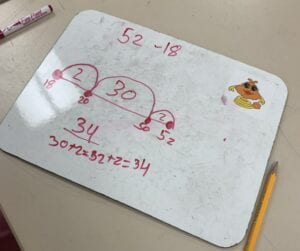 Let’s take a subtraction problem – 52-18. Since Springling secretly wants to add and loves to count up, she starts at the 18. She also likes to hop on friendly numbers to make it easier to count up. So, if she starts at 18, then we all say “Hop, Springling! Hop!” and, even though I’m just drawing an arc between numbers on the whiteboard, the kids get really excited as she “hops” up the number line to the 20, the next friendly number. Then, she hops to her destination, which is 52 (either in one BIG hop or several smaller hops). I ask how many hops she made and how far she went, and the kids can easily see add up the hops to find the answer to the problem because it’s all laid out on the number line.
Let’s take a subtraction problem – 52-18. Since Springling secretly wants to add and loves to count up, she starts at the 18. She also likes to hop on friendly numbers to make it easier to count up. So, if she starts at 18, then we all say “Hop, Springling! Hop!” and, even though I’m just drawing an arc between numbers on the whiteboard, the kids get really excited as she “hops” up the number line to the 20, the next friendly number. Then, she hops to her destination, which is 52 (either in one BIG hop or several smaller hops). I ask how many hops she made and how far she went, and the kids can easily see add up the hops to find the answer to the problem because it’s all laid out on the number line.
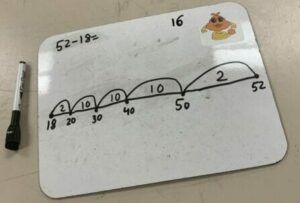 Think about a child in 1st or 2nd grade doing a simple subtraction problem like 13-7. They realize they only have 10 fingers so they can’t really just take away fingers. Then they start using their fingers to count back from 13, but they end up losing track or skipping fingers and just getting generally confused. For these kids who are really struggling with the concept of subtraction, Springling brings visual clarity! They understand that she really just wants to add, so she counts her hops on her way up the open number. We use an open number line because we can start and stop anywhere we want or need to, as opposed to some of the math books that always start the number line at 0, which can be confusing.
Think about a child in 1st or 2nd grade doing a simple subtraction problem like 13-7. They realize they only have 10 fingers so they can’t really just take away fingers. Then they start using their fingers to count back from 13, but they end up losing track or skipping fingers and just getting generally confused. For these kids who are really struggling with the concept of subtraction, Springling brings visual clarity! They understand that she really just wants to add, so she counts her hops on her way up the open number. We use an open number line because we can start and stop anywhere we want or need to, as opposed to some of the math books that always start the number line at 0, which can be confusing.
Springling grows with students because, as they get older, they start to deal with things that aren’t always whole numbers. They might have a whole number with a decimal, or they might have money with dollars and cents, or fractions with a whole number and a fractional part, or time with hours and minutes.
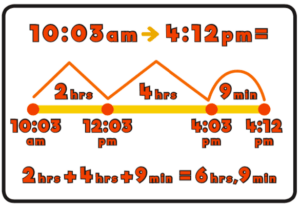 If Springling is working with time, she can help make it easier for the kids. If we had 30 minutes, plus 2 hrs and 12 minutes, we can use her number line. Visually, we use a peak for the whole value (number, hour, dollar, etc.) and a smaller arc for the parts of a whole (fractions, minutes, cents, etc.) It helps students differentiate easily as they’re looking at Springling and “adding” up her hops.
If Springling is working with time, she can help make it easier for the kids. If we had 30 minutes, plus 2 hrs and 12 minutes, we can use her number line. Visually, we use a peak for the whole value (number, hour, dollar, etc.) and a smaller arc for the parts of a whole (fractions, minutes, cents, etc.) It helps students differentiate easily as they’re looking at Springling and “adding” up her hops.
The new Subtraction Strategies Poster will also have a download companion available, as the Addition Strategies Poster does, so that, as you feel that the kids get the strategy, you can stretch them to practice it with different problems.
Preorders for the Math Mights Subtraction Strategies Poster will start towards the end of May 2019 – stay tuned for more details!!



